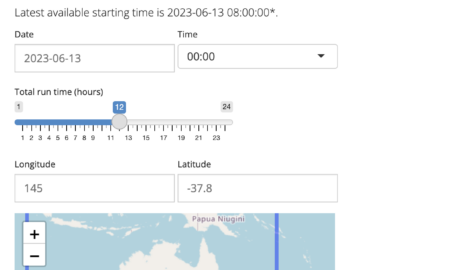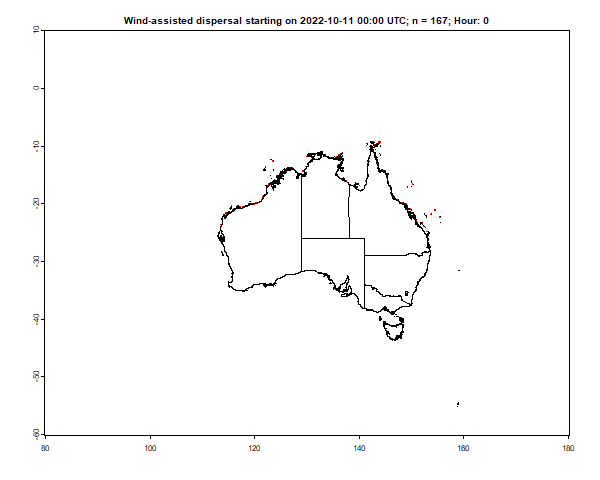Wind Dispersal Forecasting Tool
Monitoring tool Seasonal advice
This is an app developed by Cesar Australia to predict the wind-assisted dispersal of Fall Armyworm (FAW; Spodoptera frugiperda).
The app runs real-time simulations of dispersal using the cellular automata model, allowing users to predict the direction and distance that FAW will travel under different scenarios.
FAW is lepidopteran pest species which causes major damage to economically important cultivated grasses, vegetable crops, and cotton. It was first reported in Australia in January 2020, and has rapidly spread across Eastern Australia.
Cellular automata model for wind-assisted dispersal
The cellular automata (CA) model for wind-assisted dispersal was developed by Cesar Australia research scientists as part of a project funded by Plant Health Australia to help predict movements of FAW in Australia.
The CA algorithm was developed to provide quick and efficient simulations of the direction and speed that FAW will travel via wind-assisted dispersal. The model incorporates both localised information and broad scale weather data to calculate where the moths will disperse to from selected starting locations.

A full description of the model and validation against recorded FAW movements in Eastern Australia will be made available when published.
Data used for simulations
Meteorological forecast cycles in 6 hour intervals (UTC 00:00, 06:00, 12:00, 18:00) at a 0.25 degrees spatial resolution (roughly 25 x 25 km) are sourced from the NOAA Global Forecast System (GFS). Data are downloaded daily at 08:00 AEST and are kept for a week.
Using the forecasting tool
The default use of the tool is to perform a Rapid simulation based on user-defined input. You will be prompted to select among several parameters:

1. Select whether to run the simulation forwards (i.e. showing where the moths are predicted to disperse to) or backwards (i.e. predicting where the moths came from).

2. Select a timezone and date and time for your simulation. You can run simulations ranging up to a week prior to the current date.

3. Select the total flight duration of FAW, up to 24 hours for forward simulation, up to 96 hours (four days) for backward simulation.

4. Locality: The location of moths present to predict their direction of travel (forwards) or their predicted origin (backwards). You can click on the map to select up to five localities for the simulation. Delete selected localities by pressing on the adjacent button.
Note that longer total run times and greater numbers of localities will result in longer computation times, up to three minutes for forwards simulations and up to 11 minutes for backwards simulations. If that time has passed and no output has been created, please refresh and try again. If the error persists, contact Cesar Australia for support.
After you have selected all of your starting conditions, press the Run forecast button. After a short wait the results of your simulation will show up on the right, with cells coloured based on the frequency of simulated trajectories passing through them.
Alternatively, you can switch to the Multi-site Northern Prediction tab to simulate overnight dispersal from localities where there is a year-round risk of FAW. Select your timezone of choice, and press the Run forecast button to generate a map of where FAW may have dispersed to overnight. This should take roughly eight minutes to produce.
For more information on surveillance and how to monitor for and manage FAW see:
The Beatsheet article – QLD
NSWDPI surveillance – NSW
PestFacts south-eastern article – Vic
Contact details
For any questions about the model, suggestions for the online tool, or requests for information or new functionalities, please contact Alex Slavenko at Cesar Australia.
This tool was developed by Dr Alex Slavenko at Cesar Australia for project “Rapid real-time simulation of wind-assisted long-ranged dispersal of FAW in Australia” with funding from Plant Health Australia (PHA).
- Published
- Categories
- Biosecurity, Integrated pest management
